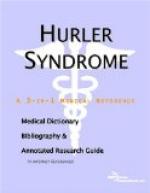|
This section contains 289 words (approx. 1 page at 300 words per page) |
A severe genetic disorder that causes skeletal deformity and mental retardation.
Hurler's syndrome belongs to the broader category of mucopolysaccharidosis (MPS), a type of disease caused by an excess accumulation of certain substances (mucopolysaccharides) found in connective tissue. There are six major types of mucopolysaccharidosis, all produced by various enzyme deficiencies that cause mucopolysaccharides to be stored in cells. It is possible to screen for these conditions because the stored mucopolysaccharides leak into the urine. MPS occurs in an estimated 1 in 25,000 live births.
Hurler's syndrome, named for Gertrud Hurler (1889-1965), the German pediatrician who first identified the condition in 1919, is one of the more common forms of mucopolysaccharidosis. Like most other types of MPS, it is an autosomal recessive trait. Caused by a deficiency in the enzyme alpha-L-iduronidase, it is characterized by mental and growth retardation, short, broad bones, a humpback, joint stiffness, and limited joint function. Children with Hurler's syndrome have slow growth during the second six months of life and generally stop growing altogether by the age of two. The corneas become clouded, and facial deformities develop, including a prominent forehead, coarse features, thick earlobes, a sunken nasal bridge, excessively full lips, and upturned nostrils. The spine becomes shortened, the liver and spleen enlarged, the chest deformed, and the abdomen protruding. After the age of three, the mouth is usually held open. Children afflicted by Hurler's syndrome usually die by the age of 10 from heart failure or pneumonia. Recently, physicians have had some success in treating the condition with bone marrow transplants. Prenatal screening for Hurler's syndrome may be done through either amniocentesis or chorionic villus sampling by testing for levels of the associated enzyme in cultured fetal cells.
|
This section contains 289 words (approx. 1 page at 300 words per page) |


